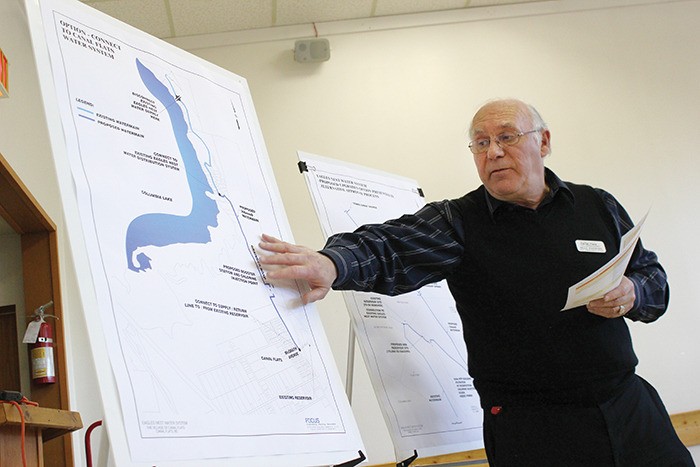Referenda are on the agenda following a five-hour meeting in Canal Flats on Saturday, March 9th, as residents and councillors attempted to unravel the Eagle’s Nest water issue ahead of a looming grant deadline.
The village neighbourhood, which has been under a boil water advisory for a decade, must upgrade its water system by January 2015 to meet Interior Health standards. But unless provincial approval for a one-year extension is received, the village must find a way to apply the remaining funds of a $400,000 Towns for Tomorrow grant by March 31st.
“If we don’t get the extension, I’m not too sure what we’re going to do at this point,” Canal Flats chief administrative officer Brian Woodward told The Echo. Though the village and the Ministry of Community, Sport and Cultural
Development agree on the urgency of the situation, no meeting has been set up so far, meaning the $269,000 remaining in the grant, which dates back to 2007, could simply evaporate.
The crux of the issue is the cost incurred on those who own the 62 properties in the Eagle’s Nest and Painted Ridge subdivisions, who are on a separate water service area than the rest of the village.
A list of six initial options for providing potable water to the neighbourhood has now boiled down to two front-running ideas — building a new standalone spring-fed water reservoir adjacent to the Eagles’ Nest area, or connecting the Eagle’s Nest water system to the village’s water system via a 12-inch water main stretching nearly three kilometres.
Eagle’s Nest water is currently stored in a small wooden reservoir that dates back to 1969, and bears stains from water that slowly soaks through its side. It’s also located at the end of rough road that itself incurs significant maintenance costs.
While early engineering estimates peg each option at roughly $1.6 million in capital cost, the yearly operating costs differ substantially — a new reservoir in the Eagle’s Nest area would cost about $2,000 per resident to run each year, while pumping costs associated with an extended water main are estimated at $660 per resident per year.
Extending the water line would carry an additional related cost — building an $800,000 reservoir that would be large enough to service both Canal Flats and the Eagle’s Nest neighbourhood. In
either scenario, operating costs would be borne by residents in the Eagles Nest Water Service area, while capital costs would be shared between residents of the village, residents of Eagle’s Nest, and remaining grant funds.
At issue for many Eagle’s Nest homeowners at the Saturday meeting was the original intent of the grant, as many believed it was meant solely for Eagle’s Nest and should not be directed towards general water improvements. Consensus at the meeting began to emerge towards connecting the Eagle’s Nest and village water systems.
“This is the first time I’ve heard about doing the combined water systems; I like it,” said Eagle’s Nest resident Sue Wertz, amidst murmurs of agreement. “If the capital costs are the same, it absolutely makes sense.”
To simplify the process and share costs most equally among the just over 500 water users in Canal Flats and Eagle’s Nest, those at the meeting agreed to pursue two referenda: to see whether Eagle’s Nest and village residents are in favour of dissolving the two separate water service areas, and merging into one. That idea was pursued at Canal Flats’ Monday, March 11 council meeting, which took place after the Echo’s press deadline. Mr. Woodward also sought council assent to get a final engineering design on the connection option, which could result in cost variances of up to 15 per cent.
Border issues make referenda a complicated option, as just 15 Eagle’s Nest area homeowners are full-time B.C. residents. An Alternate Approval Process (AAP) undertaken by the village last summer failed
to garner the support needed to move ahead on a joint water system, after which the village sought an Interior Health order to build it, in the hopes of getting around the need to convince landowners of the benefits. That backfired on the village, as Interior Health agreed on the urgency of the matter but reiterated the village was obliged to follow the normal municipal process to get approval to spend the money.
Point-of-entry treatment (such as a home ultraviolet system) for Eagle’s Nest water was also considered, though dismissed due to operating costs that would likely exceed $3,000 per year, due to the Interior Health requirement that the water would need to be tested weekly.
At the Saturday meeting, former Canal Flats chief administrative officer (and later mayor) Bruce Woodbury questioned how safe the village’s drinking water is, given it draws from shallow wells. An engineering representative said she didn’t believe Interior Health would take issue with it, and when asked by several residents which option she would choose, said connecting the two water systems is the best way to go.
